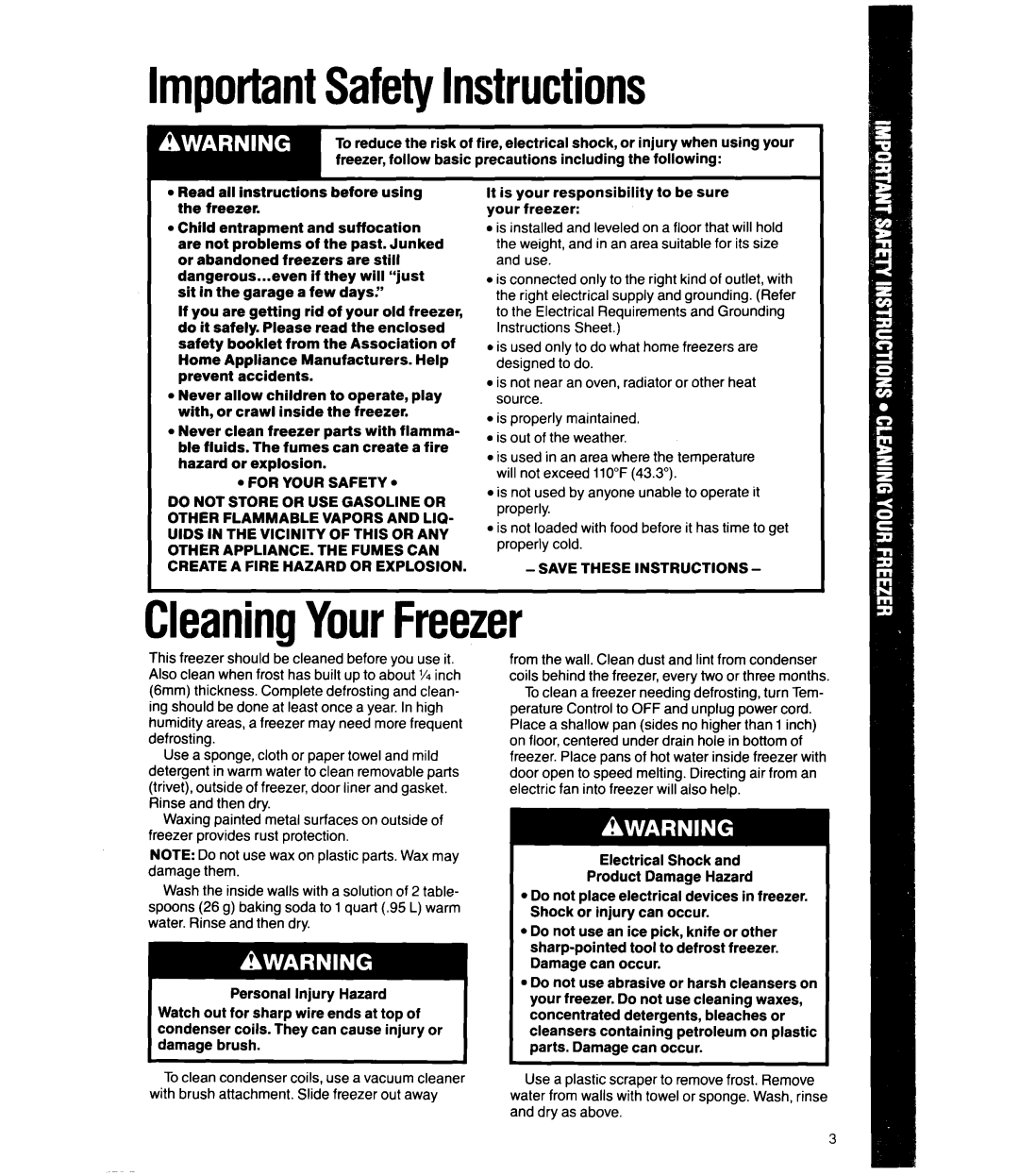
ImportantSafetyInstructions
To reduce the risk of fire, electrical freezer, follow basic precautions
shock, or injury when using your including the following:
l Read all instructions before using the freezer.
l Child entrapment and suffocation are not problems of the past. Junked or abandoned freezers are still
dangerous...even if they will “just sit in the garage a few days.”
If you are getting rid of your old freezer, do it safely. Please read the enclosed safety booklet from the Association of
Home Appliance Manufacturers. Help prevent accidents.
l Never allow children to operate, play with, or crawl inside the freezer.
l Never clean freezer parts with flamma- ble fluids. The fumes can create a fire hazard or explosion.
l FOR YOUR SAFETY l
DO NOT STORE OR USE GASOLINE OR OTHER FLAMMABLE VAPORS AND LIG- UIDS IN THE VICINITY OF THIS OR ANY OTHER APPLIANCE. THE FUMES CAN CREATE A FIRE HAZARD OR EXPLOSION.
It is your responsibility to be sure your freezer:
l is installed and leveled on a floor that will hold the weight, and in an area suitable for its size and use.
l is connected only to the right kind of outlet, with the right electrical supply and grounding. (Refer to the Electrical Requirements and Grounding Instructions Sheet.)
l is used only to do what home freezers are designed to do.
lis not near an oven, radiator or other heat source.
l is properly maintained.
lis out of the weather.
l is used in an area where the temperature will not exceed 110°F (43.3”).
l is not used by anyone unable to operate it properly.
lis not loaded with food before it has time to get properly cold.
-SAVE THESE INSTRUCTIONS -
CleaningYourFreezer
This freezer should be cleaned before you use it. Also clean when frost has built up to about ‘/4inch (6mm) thickness. Complete defrosting and clean- ing should be done at least once a year. In high humidity areas, a freezer may need more frequent defrosting.
Use a sponge, cloth or paper towel and mild detergent in warm water to clean removable parts (trivet), outside of freezer, door liner and gasket. Rinse and then dry.
Waxing painted metal surfaces on outside of freezer provides rust protection.
NOTE: Do not use wax on plastic parts. Wax may damage them.
Wash the inside walls with a solution of 2 table- spoons (26 g) baking soda to 1 quart (.95 L) warm water. Rinse and then dry.
Personal Injury Hazard Watch out for sharp wire ends at top of condenser coils. They can cause injury or damage brush.
To clean condenser coils, use a vacuum cleaner with brush attachment. Slide freezer out away
from the wall. Clean dust and lint from condenser coils behind the freezer, every two or three months.
To clean a freezer needing defrosting, turn Tem- perature Control to OFF and unplug power cord. Place a shallow pan (sides no higher than 1 inch) on floor, centered under drain hole in bottom of freezer. Place pans of hot water inside freezer with door open to speed melting. Directing air from an electric fan into freezer will also help.
Electrical Shock and
Product Damage Hazard
l Do not place electrical devices in freezer. Shock or injury can occur.
l Do not use an ice pick, knife or other
l Do not use abrasive or harsh cleansers on your freezer. Do not use cleaning waxes, concentrated detergents, bleaches or cleansers containing petroleum on plastic parts. Damage can occur.
Use a plastic scraper to remove frost. Remove
water from walls with towel or sponge. Wash, rinse and dry as above.
